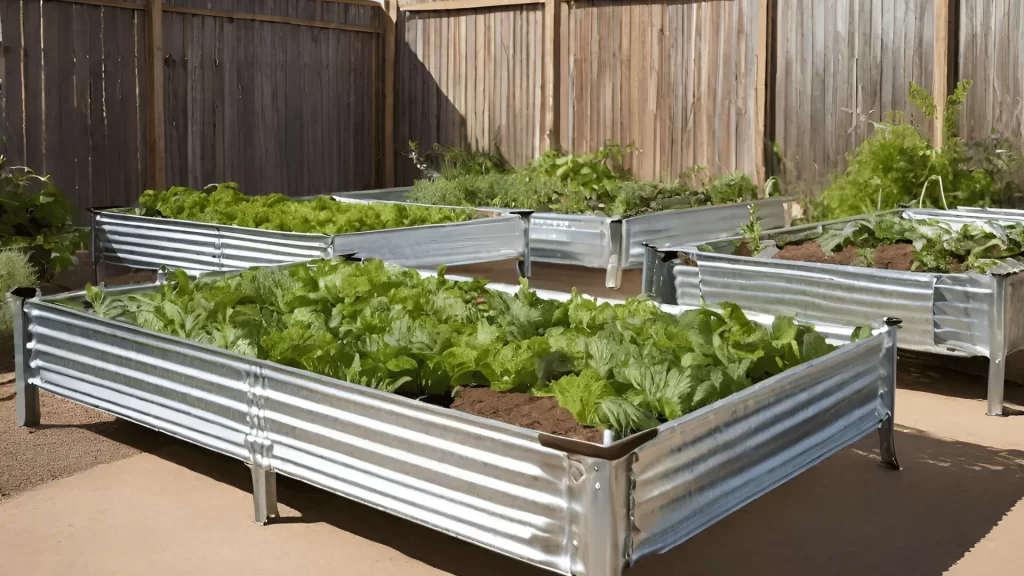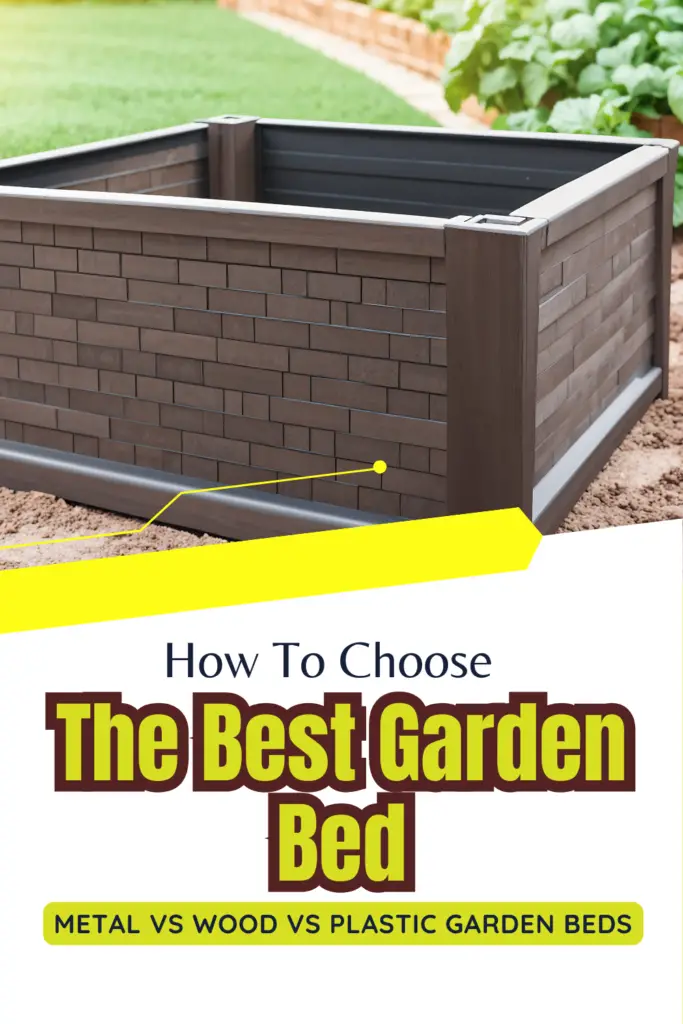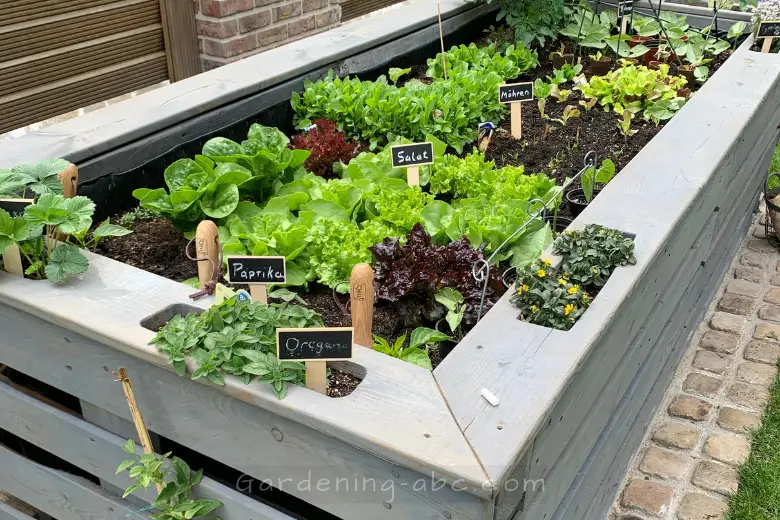We use affiliate links to run our site. When you buy through links on our site, we may earn an affiliate commission, without any added cost to you. Learn more
Garden beds are a popular choice among gardening enthusiasts as they offer numerous benefits, including better soil drainage, weed control, and improved accessibility.
When it comes to selecting the right garden bed, one of the crucial decisions you’ll face is choosing the appropriate material. Metal, wood, and plastic are three commonly used materials for garden beds, each with its own set of advantages and disadvantages.
In this article, we will compare metal garden beds with wooden and plastic alternatives to help you make an informed decision for your gardening needs.
Metal Garden Beds

Metal garden beds are known for their durability and longevity, making them a popular choice for gardeners seeking a long-term investment. These beds are typically made from materials such as galvanized steel or aluminum.
One of the primary advantages of metal garden beds is their resistance to pests and rot. Unlike wood, metal does not attract termites or other insects, ensuring the bed’s longevity.
They are also excellent at absorbing and retaining heat, providing a warm environment for plants during cooler seasons.
Metal garden beds often come with customization options, allowing you to choose the size and shape that best suits your garden layout.
However, metal garden beds do have a few disadvantages. Over time, they can be prone to rust and corrosion, especially if the protective coating is compromised.
One solution to this is to use galvanized steel beds, that are designed to resist rust.
Also, in warmer climates, metal beds may retain excessive heat, potentially affecting plant growth. If you live in such areas you may have to consider insulation options like shade covers or mulch to regulate the temperature.
Wooden Garden Beds

Wooden garden beds offer a natural and aesthetically pleasing option for gardeners. They blend seamlessly with the surrounding environment and can enhance the overall look of your garden.
One of the key advantages of wooden garden beds is their breathability and moisture control. Wood naturally allows air and water to circulate within the soil, promoting healthier root systems and preventing waterlogging.
Furthermore, wood has excellent insulation properties, which can be beneficial in regions with fluctuating temperatures. It helps regulate soil temperature, keeping it cooler in hot weather and warmer during colder seasons.
Wooden garden beds are also relatively easy to customize and assemble. You can easily adjust their dimensions and shape to fit your garden space or even add trellises for climbing plants.
However, wooden garden beds do have a few drawbacks. They are more susceptible to rot and pests compared to metal or plastic.
To address this, it’s essential to choose rot-resistant wood, such as cedar or redwood, or treat the wood with a protective sealant. Despite these precautions, wooden beds generally have a limited lifespan compared to metal alternatives.
Wooden garden beds also require regular maintenance. They may need resealing or painting every few years to prolong their lifespan and maintain their appearance.
Also, consider the environmental impact of using wood. Opting for sustainably sourced or reclaimed wood can help mitigate the negative ecological consequences associated with deforestation.
Plastic Garden Beds

Plastic garden beds are a popular choice for those seeking lightweight and affordable options. They are usually made from durable materials like recycled HDPE (high-density polyethylene) or polypropylene.
One of the primary advantages of plastic garden beds is their lightweight nature, making them easy to move and rearrange as needed. They are also resistant to moisture, preventing rot and decay.
Plastic beds have low maintenance requirements. They don’t require sealing or painting, and they are less prone to damage from pests or extreme weather conditions.
Moreover, plastic garden beds are generally more affordable compared to metal or wooden alternatives. They are readily available in various sizes and shapes, making them accessible to gardeners with different budgets.
However, plastic garden beds have their limitations.
They may lack the aesthetic appeal that metal or wooden beds offer. Plastic is also less durable compared to metal or wood, and it may be more prone to cracking or breaking over time.
Furthermore, there is a concern about potential chemical leaching from certain types of plastic beds. It’s crucial to choose food-grade or BPA-free plastic options to ensure the safety of your plants.
How To Choose The Right Garden Bed Material
When comparing metal, wooden, and plastic garden beds, it’s important to consider several factors to make an informed decision:
- Climate and weather conditions: Consider the local climate and weather patterns. Metal beds may retain heat, wooden beds offer insulation, and plastic beds withstand moisture.
- Budget and affordability: Determine your budget and choose a garden bed material that fits within your financial constraints. Plastic beds are generally the most affordable option.
- Aesthetic preferences: Consider the overall look and feel you want for your garden. Wooden beds provide a natural and rustic appeal, while metal beds offer a sleek and modern appearance.
- Longevity and maintenance requirements: Assess how much time and effort you are willing to invest in maintaining your garden beds. Metal beds tend to have a longer lifespan, while wooden beds require periodic maintenance.
- Environmental impact: Evaluate the eco-friendliness of each material. Wooden beds can be sourced sustainably, while plastic beds have recycling considerations.
- Customization options: Determine if you have specific requirements for bed size, shape, or additional features. Metal and wooden beds often offer more customization options compared to plastic beds.
What we recommend:
In search of a reliable and durable raised garden bed, we just stumbled upon this VEGEGA Raised Garden Bed Kit.
This exceptional planter box is constructed with Zinc-Aluminum-Magnesium Stainless Steel, making it a long-lasting investment that outperforms regular galvanized beds and withstands greater pressure.
Designed with the gardener’s comfort in mind, the Zinc-Aluminum-Magnesium Stainless Steel material used in this bed reflects heat, ensuring that your plants stay cool and healthy even in scorching temperatures.
The Zinc-Aluminum-Magnesium Stainless Steel material is environmentally friendly, and it remains intact without leaching or breaking down over time.
One common concern with garden beds is water drainage, as excessive moisture can harm plants. The VEGEGA garden bed addresses this issue with its open bottom and well-designed drainage system, ensuring proper water flow and preventing water-related problems like necrosis.
Versatility is another standout feature of this garden bed. With its ingenious 9-in-1 modular design, you have the freedom to configure the bed into 9 different shapes to perfectly suit your garden layout and preferences.
The bed also includes a thoughtful rubber clip-on safety cover strip, providing added protection and peace of mind.
Being a metal raised bed its lifespan is an impressive 7 times longer than wooden or plastic alternatives, providing you with a garden bed that will serve you faithfully for years to come.
This garden bed has garnered positive feedback from satisfied customers who appreciate its maneuverability, sturdiness, ease of assembly, and excellent value for money.
The VEGEGA Raised Garden Bed Kit comes with all the necessary hardware, including bolts, nuts, washers, and an instruction manual, making assembly a breeze.
You can find more about this bed here.
Are metal garden beds safe for growing vegetables?
Metal garden beds are safe for growing vegetables as long as they are made from food-safe materials like galvanized steel or aluminum. Avoid using untreated metal that may contain harmful substances.
Can wooden garden beds be painted or stained?
Yes, wooden garden beds can be painted or stained to enhance their appearance and protect the wood. Ensure you use non-toxic paints or stains that are safe for plants.
Do plastic garden beds require any special maintenance?
Plastic garden beds have minimal maintenance requirements. Simply keep them clean and free of debris. Avoid exposing them to harsh sunlight for extended periods to prevent degradation.
Which garden bed material is the most eco-friendly?
Wooden garden beds made from sustainably sourced or reclaimed wood are generally considered the most eco-friendly option. However, using recycled plastic beds can also contribute to reducing waste.
Can I use different materials for different sections of my garden?
Yes, you can use different materials for different sections of your garden based on your specific needs and preferences. This allows you to optimize each area according to its requirements.

Conclusion
We hope this comprehensive guide comparing metal, wooden, and plastic garden beds has provided you with valuable insights to make an informed decision for your gardening endeavors.
By considering factors such as climate, budget, aesthetics, longevity, maintenance, environmental impact, and customization options, you can choose the perfect garden bed material that suits your unique needs and preferences.
If you found this article helpful, we encourage you to share it with fellow gardening enthusiasts who may benefit from the information. Sharing knowledge fosters a thriving community of gardeners and allows us to connect and learn from one another.
For more informative articles and helpful tips, be sure to explore other posts on our website. We cover a wide range of gardening topics to support you in creating and maintaining a beautiful and flourishing garden.
Now that you have gained valuable insights into the pros and cons of different garden bed materials, it’s time to take action.
Amazon and the Amazon logo are trademarks of Amazon.com, Inc, or its affiliates.

Hi there! My name is Prasenjit and I’m an avid gardener and someone who has grown a passion for growing plants. From my hands-on experience, I have learned what works and what doesn’t. Here I share everything I have learned.

